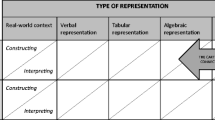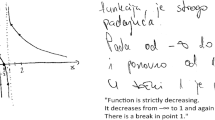Abstract
This paper examines prospective mathematics teachers’ knowledge of asymptotes and asymptotic behaviour of functions in calculus. They are university students and future facilitators of knowledge in upper secondary education. We constructed a reference epistemological model to describe the knowledge about asymptotes for upper secondary and university education and explored prospective teachers’ relations to targeted knowledge. The study was conducted within the Anthropological Theory of the Didactic as a suitable framework to analyse and interpret knowledge of mathematical notions. Prospective teachers participated in three questionnaires with open, non-routine questions on different aspects of the notion of asymptotes. An analysis showed their knowledge was fragmented and their work relied heavily on algebraic manipulation and memorized formulas from calculus. The results indicated that knowledge of asymptotes and asymptotic behaviour is a potentially powerful context for developing knowledge related to the limits of functions in calculus.







Similar content being viewed by others
References
Barbé, J., Bosch, M., Espinoza, L., & Gascón, J. (2005). Didactic restrictions on the teacher’s practice: The case of limits of functions in Spanish high schools. Educational Studies in Mathematics, 59, 235–268.
Berger, L. (2018). Attending to precision: Mathematical definitions in courses for pre-service and practicing teachers. PRIMUS, 28(8), 772–784.
Berger, M., & Bowie, L. (2012). A course on functions for in-service mathematics teachers: Changing the discourse. Education as Change, 16(2), 217–229.
Beynon, K. A., & Zollman, A. (2015). Lacking a formal concept of limit: Advanced non-mathematics students’ personal concept definitions. Investigations in Mathematics Learning, 8(1), 47–62.
Bezuidenhout, J. (2001). Limits and continuity: Some conceptions of first-year students. International Journal of Mathematical Education in Science and Technology, 32(4), 487–500.
Biza, I., & Zachariades, T. (2010). First year mathematics undergraduates’ settled images of tangent line. The Journal of Mathematical Behavior, 29(4), 218–229.
Bosch, M., Chevallard, Y., García, F. J., & Monaghan, J. (Eds.). (2020). Working with the anthropological theory of the didactic in mathematics education. Routledge.
Burton, D. (2011). The history of mathematics: An introduction (7th ed.). McGraw-Hill.
Čižmešija, A., Katalenić, A., & Milin Šipuš, Ž. (2017). Asymptote as a body of knowledge to be taught in textbooks for Croatian secondary education. In Z. Kolar-Begović, R. Kolar-Šuper, & L. Jukić-Matić (Eds.), Mathematics education as a science and a profession (pp. 127–147). Element.
Chevallard, Y. (1992). A theoretical approach to curricula. Journal Für Mathematik-Didaktik, 13, 215–230.
Chevallard, Y. (2007). Readjusting didactics to a changing epistemology. European Educational Research Journal, 6(2), 131–134.
Chevallard, Y. (2019). Introducing the anthropological theory of the didactic: An attempt at a principled approach. Hiroshima Journal of Mathematics Education, 12, 71–114.
Chevallard, Y., & Bosch, M. (2014). Didactic transposition in mathematics education. In S. Lerman (Ed.), Encyclopedia of Mathematics Education (pp. 170–174). Springer.
Conner, A. (2013). Authentic argumentation with prospective secondary teachers: The case of 0.999 …. Mathematics. Teacher Educator, 1(2), 172–180.
Corica, A. R., & Otero, M. R. (2012). Estudio sobre las Praxeologías que se Proponen Estudiaren un Curso Universitario de Cálculo [Study of the praxeologies proposed to study in a university calculus course]. Bolema: Boletim de Educação Matemática, 26(42b), 459–482.
Cottrill, J., Dubinsky, E., Nichols, D., Schwingendorf, K., Thomas, K., & Vidakovic, D. (1996). Understanding the limit concept: Beginning with a coordinated process scheme. The Journal of Mathematical Behavior, 15(2), 167–192.
Dahl, B. (2017). First-year non-STEM majors’ use of definitions to solve calculus tasks: benefits of using concept image over concept definition? International Journal of Science and Mathematics Education, 15(7), 1303–1322.
De Bruijn, N. G. (1958). Asymptotic methods in analysis. North-Holland Publishing.
Dobbs, D. E. (2011). Polynomial asymptotes of the second kind. International Journal of Mathematical Education in Science and Technology, 42(2), 276–282.
Elia, I., Gagatsis, A., Panaoura, A., Zachariades, T., & Zoulinaki, F. (2009). Geometric and algebraic approaches in the concept of “limit” and the impact of the “didactic contract”. International Journal of Science and Mathematics Education, 7, 765–790.
Fernández-Plaza, J. A., & Simpson, A. (2016). Three concepts or one? Students’ understanding of basic limit concepts. Educational Studies in Mathematics, 93(3), 315–332.
García, F. J., Pérez, J. G., Higueras, L. R., & Bosch, M. (2006). Mathematical modelling as a tool for the connection of school mathematics. ZDM, 38(3), 226–246.
Giblin, P. J. (1972). What is an Asymptote? The Mathematical Gazette, 56(398), 274–284.
Gravesen, K. F., Grønbæk, N., & Winsløw, C. (2017). Task design for students’ work with basic theory in analysis: The cases of multidimensional differentiability and curve integrals. International Journal of Research in Undergraduate Mathematics Education, 3, 9–33.
Güçler, B. (2016). Making implicit metalevel rules of the discourse on function explicit topics of reflection in the classroom to foster student learning. Educational Studies in Mathematics, 91(3), 375–393.
Janaszak, T. (2013). Some remarks on horizontal, slant, parabolic and polynomial asymptote. Didactics of Mathematics, 10(14), 45–56.
Kajander, A., & Lovric, M. (2009). Mathematics textbooks and their potential role in supporting misconceptions. International Journal of Mathematical Education in Science and Technology, 40(2), 173–181.
Katalenić, A., Milin Šipuš, Ž., & Čižmešija, A. (2020). Asymptotes and asymptotic behaviour in graphing functions and curves: An analysis of the croatian upper secondary education within the anthropological theory of the didactic. International Journal of Science and Mathematics Education, 18, 1185–1205.
Kidron, I. (2011). Constructing knowledge about the notion of limit in the definition of the horizontal asymptote. International Journal of Science and Mathematics Education, 9, 1261–1279.
Milin Šipuš, Ž., Čižmešija, A., & Katalenić, A. (2019). Redesigning a contextual textbook task with an exponential-type function using a posteriori analysis of the prospective mathematics teachers’ work. In Z. Kolar-Begović, R. Kolar-Šuper, & L. Jukić Matić (Eds.), Towards new perspectives on mathematics education (pp. 173–191). Element.
Mok, I., & Johnson, D. (2000). Reasoning algebraically with IT: A cognitive perspective. Mathematics Education Research Journal, 12(3), 286–302.
Moru, E. K. (2009). Epistemological obstacles in coming to understand the limit of a function at undergraduate level: A case from the National university of Lesotho. International Journal of Science and Mathematics Education, 7(3), 431–454.
Mpofu, S., & Pournara, C. (2018). Learner participation in the functions discourse: A focus on asymptotes of the hyperbola. African Journal of Research in Mathematics, Science and Technology Education, 22(1), 2–13.
Mudaly, V., & Mpofu, S. (2019). Learners’ views on asymptotes of a hyperbola and exponential function: A commognitive approach. Problems of Education in the 21st Century, 77(6), 734–744.
Nachlieli, T., & Tabach, M. (2012). Growing mathematical objects in the classroom – The case of function. International Journal of Educational Research, 51–52, 10–27.
Nair, G. S. (2010). College students’ concept images of asymptotes, limits, and continuity of rational functions [The Ohio State University]. https://etd.ohiolink.edu/apexprod/rws_olink/r/1501/10?clear=10&p10_accession_num=osu1282259818
Przenioslo, M. (2004). Images of the limit of function formed in the course of mathematical studies at the university. Educational Studies in Mathematics, 55, 103–132.
Raman, M. (2002). Coordinating informal and formal aspects of mathematics: Student behavior and textbook messages. The Journal of Mathematical Behavior, 21(2), 135–150.
Roh, K. H. (2008). Students’ images and their understanding of definitions of the limit of a sequence. Educational Studies in Mathematics, 69(3), 217–233.
Salas, S., Hille, E., & Etgen, G. (2007). Calculus: One and several variables (10th ed.). John Wiley & Sons.
Swinyard, C., & Larsen, S. (2012). Coming to understand the formal definition of limit: Insights gained from engaging students in reinvention. Journal for Research in Mathematics Education, 43(4), 465–493.
Szydlik, J. E. (2000). Mathematical beliefs and conceptual understanding of the limit of a function. Journal for Research in Mathematics Education, 31(3), 258–276.
Tall, D., & Vinner, S. (1981). Concept image and concept definition in mathematics with particular reference to limits and continuity. Educational Studies in Mathematics, 12(2), 151–169.
Vandebrouck, F., & Leidwanger, S. (2016). Students’ vizualisation of functions from secondary to tertiary level. First Conference of International Network for Didactic Research in University Mathematics.
Williams, S. R. (1991). Models of limit held by college calculus students. Journal for Research in Mathematics Education, 22(3), 219–236.
Winsløw, C., Barquero, B., Vleeschouwer, M. D., & Hardy, N. (2014). An institutional approach to university mathematics education: From dual vector spaces to questioning the world. Research in Mathematics Education, 16(2), 95–111.
Winsløw, C., & Grønbæk, N. (2014). Klein’s double discontinuity revisited: Contemporary challenges for universities preparing teachers to teach calculus. Recherches En Didactique Des Mathématiques, 34(1), 59–86.
Yerushalmy, M. (1997). Reaching the unreachable: Technology and the semantics of asymptotes. International Journal of Computers for Mathematical Learning, 2, 1–25.
Zarhouti, M. K., Mouradi, M., & Maroufi, A. E. (2014). The teaching of the function at high school: The graphic representation of a function at first year, section experimental sciences. IOSR Journal of Research & Method in Education, 4(3), 56–65.
Author information
Authors and Affiliations
Corresponding author
Appendix
Appendix
Question 1.1 Sketch a graph of the function \(f(x)=\frac{2x-1}{x-1}\). Explain.
Question 1.3 It is expected that the percentage (expressed as a decimal) of viewers who will respond to a commercial message for a new product after t days, behaves according to the formula o(t) = 0.7 – 2–t.
(a) Represent the given relationship o(t) graphically.
(b) What is the expected percentage of viewers who will respond to the commercial message after 7 days?
(c) Describe the behaviour of the expected percentage of viewers who will respond to the commercial message as the days pass.
Question 2.2 (a) Read the following assertion:
“The line y = kx + l is the slant asymptote of a function f if \(\underset{x\boldsymbol{\to}\infty }{\lim}\left(f(x)-kx-l\right)=0\).”
Why is this true for the slant asymptote? How does that assertion fit with your description of an asymptote in the answer to the question 2.1?
(b) Explain the formulas \(k=\underset{x\to \infty }{\lim}\frac{f(x)}{x}\) and \(l=\underset{x\to \infty }{\lim}\left(f(x)- kx\right)=0\) for coefficients k and l of the function’s f slant asymptote y = kx + l.
(c) What are the conditions on the function f for the line x = a to be its vertical asymptote?
Question 2.3 The graph of the function f given by \(f(x)=x+\frac{1}{x}\) is depicted in Figure 8a. Determine the equations of the asymptotes of the function f.
Question 2.4. The function, apart from a line, can have other curves as asymptotes. In Figure 8c, the function graph is depicted by a full line and the function’s asymptotic parabola by a dotted line.
(a) Express, using mathematical symbols, the requirement for a parabola given by y = ax2 + bx + c to be an asymptotic curve of the function f.
(b) How would you find the coefficients a, b and c of the asymptotic parabola of function f?
(c) Determine the equation of the asymptotic parabola of the function f given by \(f\left(x\right)=\frac{x^3-3x^2+1}{x-1}\), according to its graph depicted in Figure 8b.
Question 3.1 In Figure 8c, a part of the graph of the function f given by \(f(x)=3x-1+\frac{\mathit{\sin}\left(4\pi x\right)}{x}\) is depicted by a full line. Determine the equation of the line depicted by the dotted line in Figure 8c. Explain.
Rights and permissions
About this article
Cite this article
Katalenić, A., Čižmešija, A. & Milin Šipuš, Ž. Prospective Mathematics Teachers’ Knowledge of Asymptotes and Asymptotic Behaviour in Calculus. Int J of Sci and Math Educ 21, 131–158 (2023). https://doi.org/10.1007/s10763-022-10247-9
Received:
Accepted:
Published:
Issue Date:
DOI: https://doi.org/10.1007/s10763-022-10247-9





